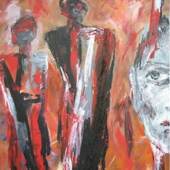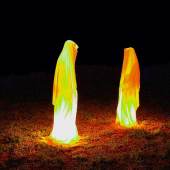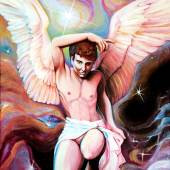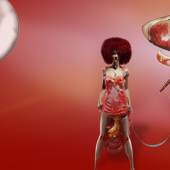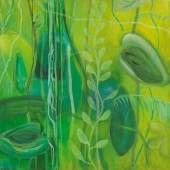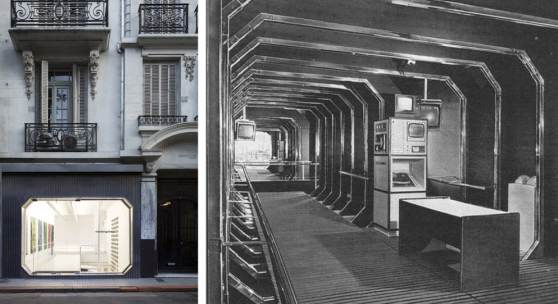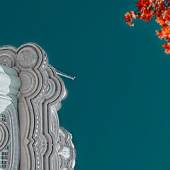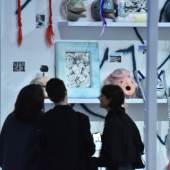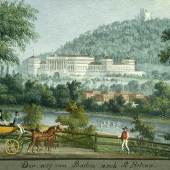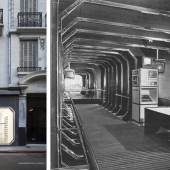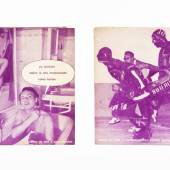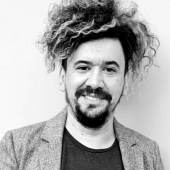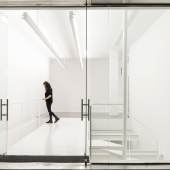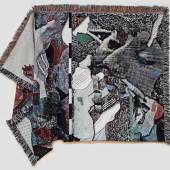Back to the future: reviving an icon of the 1970s avant-garde in Buenos Aires
-
Presse18.07.2019
How waldengallery has resurrected the spirit of Argentine futurism at the former Centro de Arte y Comunicación
On a bustling street in the Retiro neighborhood, a distinctive octagonal facade caught the eye of Ricardo Ocampo Feris, director of waldengallery, while he was walking down Viamonte Street on a stormy day last year. He took cover under the aluminum frame – reminiscent of an airlock door from a vintage sci-fi TV series – as he studied the address plaque of the building, its interior almost completely ruined. ‘452, 452.... Viamonte 452. The address kept ringing like a jingle in my head,’ recalls Ocampo Feris. ‘After a while, it struck me: that abandoned, vacant space was once the headquarters of the Centro de Arte y Comunicación,’ or Center for Art and Communication. Enthralled, he embarked on an eight-month-long quest to rent it, restore it, and resettle his La Boca gallery within this rediscovered piece of art history.
Founded in the late 1960s during a period of economic and political liberalism for Argentina, the CAyC, as it was known, became a beacon for a still-marginalized Latin American art scene. Its building on Viamonte Street, established in 1970, was neither a commercial gallery, nor a studio, nor a pedagogical center, per se: director and mastermind Jorge Glusberg (who went on to become director of the country’s national art museum) envisioned it as a hive for his wildly independent research unit, which focused on art, social sciences, political philosophy, and technology. Thumbing his nose at the Instituto Torcuato Di Tella, the reigning independent art study center in Buenos Aires, Glusberg made it clear that he had a different vision: ‘We are not going to work only with artists,’ he declared. ‘We want to intermingle every discipline and put an end to the stagnant divisions of culture.’ In his hands, the CAyC was a platform from which to imagine and materialize new – often politically insurgent – ways of living.
From the outset, the CAyC sought to make the region’s voice heard on a global register and to integrate it into the emerging information highways of the interconnected world. That ambition was crystallized in ‘Arte y cibernética’, the first exhibition organized by Glusberg and others in 1969. Mathematician Manuel Sadosky and epistemologist Gregorio Klimovsky collaborated with artists such as Antonio Berni and Josefina Robirosa on computer-aided works delivered via screens and dot-matrix printers. Works by the influential Japanese collective CTG (Computer Technique Group) were also included, an early indication of the center’s intent to function as an unofficial foreign ministry for the arts, bringing together projects from all around the world as well as disseminating Argentine art to the international community.
After just a few years, however, the promise of a techno-utopian future curdled under successive waves of political agitation in Argentina, and the 1972 exhibition ‘Arte e ideología’ took a very different tack. Instead of reflecting on integrated circuits and monochromatic phosphorus displays, the CAyC group, feeling a new urgency to plug into the street and to engage the public, conceived a large, open-air show at Plaza Rubén Darío. It featured works including Horacio Zabala’s 300 metros de cinta negra para enlutar una plaza pública, a 300-meter black mourning ribbon that ran through the square in homage to victims of state terrorism, and Jorge Gamarra’s and Víctor Grippo’s Construcción de un horno popular para hacer pan, a clay oven built in situ by two rural workers as a monument to communal knowledge and collectivism. The exhibition did succeed in engaging with reality, in a sense: within just 48 hours, it was shut down by the military government of Lieutenant General Lanusse, all its artworks confiscated or destroyed.
The significance of ‘Arte e ideología’, in particular, has come back into focus recently, with an updated restaging engineered by the experimental institution La Ene, which in 2017 hosted works by 40 contemporary artists (including Mariela Scafati, Gabriel Chaile, Flavia da Rin, Paula Castro, and Marcelo Galindo) in the very same public square, 45 years later. In the words of La Ene’s Sofía Dourron, the show allowed them to ‘revive the center’s legacy outside of the documents,’ transforming the practice of archiving into a vital, corporeal affair. ‘But above all,’ she adds, ‘it was a search for new meanings in our practices and our context through the lens of our art history.’
Now waldengallery, having moved into the facilities of the legendary research center in April of 2019, is absorbing the past that informs the present. ‘We are currently digitizing the CAyC’s archive,’ says Ocampo Feris, who was previously co-director of Document-Art, a Buenos Aires gallery with an exclusive focus on archival practices. The digitized files will become part of waldengallery’s Documentary Fund, a comprehensive database of Latin American publications and documents from the 1940s to the 1980s. The gallery has also launched an open call (until August 30, 2019) for papers on or related to the CAyC, and will publish three of them in October, 2019, upon the 50th anniversary of ‘Arte y cibernética’. Feris continues: ‘With this initiative, we aim to enrich the discourse around artistic practice in the 1970s in Latin America and promote young researchers.’
-
11.09.2018 - 16.09.2018Art Basel Cities: Buenos Aires – details announced, including Cecilia Alemani as Artistic...
-
30.08.2024 - 01.09.2024Die arteBA 2024 findet vom 30. August bis 1. September 2024 im La Rural Exhibition Center in...
-
.
-
Horst und Wolfgang Szaal über die Entwicklung der Galerie Szaal im Spiegel der Jahrzehnte In...
-
28.03.2025 - 30.03.2025Die Art Basel Hong Kong 2025 setzt neue Maßstäbe als eines der führenden Kunstereignisse weltweit...
-
18.07.2019Presse »
.

